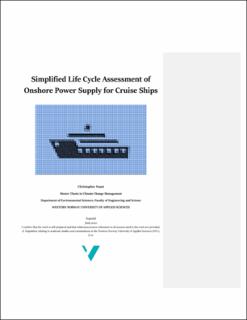| dc.description.abstract | This thesis focuses on the implementation and usage of onshore power supply (OPS) for cruise ships at berth and the reduction of emissions and air pollution caused by the latter. The thesis is considered innovative as it stands as the first study of its kind that makes use of the holistic- environmental assessment tool that is an LCA to assess the emissions caused/reduced by the implementation and consequential use of the shore power facilities. The LCA is based on a real-life implementation in Bergen and as such follows the exact composition of the latter in terms of components. Furthermore, materials and technical data has also been derived from Bergen harbour. Ultimately, the findings of the LCA showed that the emissions from the implementation of OPS are relatively low in comparison to the potential reductions achieved. However, the findings also revealed the strong dependency of reductions on demand and the electricity mixture available. For a successful reduction in emissions, shore power needs to be strongly utilized by the cruise industry, which is not the case to-date. The capabilities do exist, and more cruise ships than ever are either outfitted or retrofitted with the necessary equipment. However, only a fraction of the global cruise ship fleet is capable of receiving shore power, and still fewer do so actively-Additionally, it is recommended that the electricity mixture used is fully or partly renewable to avoid the relocating of emissions and thereby pseudo-reductions. However, the implementation and usage of OPS might still be recommended even if the electricity mixture is non-renewable as air pollution will still be eradicated. This recommendation can be made as the essence of shore power, i.e. its purpose, is the reduction of air pollution in ports and port cities rather than climate mitigation.
The figures of 1 & 2 showcase the emissions from the implementation and usage of the facility and the emissions in absence of OPS and with OPS installed, respectively. | en_US |

